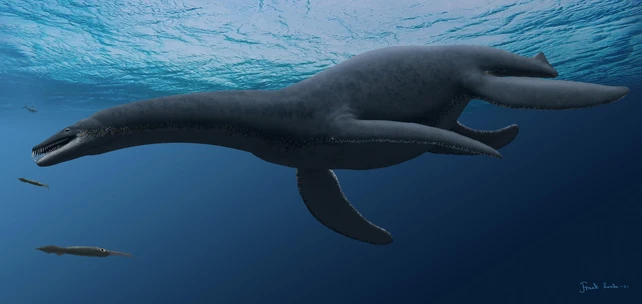
Two Cryptoclidus
In the Books[]
The cryptoclidus are grey or yellow fish-eating plesiosaurs who inhabit the planet Cryptos and have a sizeable fishing colony on the planet Aqua Minor. They can swim well, using four paddle-like flippers to travel through the water with ease. Cryptoclidus can also travel on land, although they are more awkward there. The colony's leader is the well-meaning but hasty Cripes.

Cripes the Cryptoclidus.
The cryptoclidus are not herbivores, eating fish as well as ammonites and belemnites, but most are friendly to the DSS. However, two cryptoclidus were leading members of a group of criminal sea reptiles called the Doom-Flipper Gang. The inventor Zindi Bent is also a cryptoclidus.
Species[]

Frank Lode's restoration of a Cryptoclidus underwater.
Real Cryptoclidus were medium-sized (they could grow up to 8 metres in length, but a fourth of that length was the neck) Middle Jurassic plesiosaurs which had long necks and jagged teeth for catching fish and squid. They also ate small animals at the seafloor like snails and clams. They were lightly built and could travel quickly underwater. Cryptoclidus couldn't breathe underwater, so it would have to hold its breath and occasionally come up for air like modern whales and sea turtles do. Cryptoclidus may have intentionally swallowed stones to help with ballast (improving their diving and buoyancy) and digesting food.
They lived in the Tethys Sea, a small ocean that used to be near Europe, and coexisted with Liopleurodon, a stronger and fiercer marine reptile which probably fed on its cousins. Cryptoclidus, like other long-necked plesiosaurs, didn't hunt large prey and was probably not an aggressive predator, eating fish, squid, and other small animals. Its small, fragile head and teeth meant that it couldn't overpower any prey closer to its size. Liopleurodon was also a plesiosaur, but had a larger head, a short neck, and a bulkier body - suggesting that it attacked prey much closer to its size and weight, like other plesiosaurs.
Both Cryptoclidus and Liopleurodon may have been descendants of the nothosaurs, aquatic reptiles that, unlike the plesiosaurs, were mostly still able to move on land. Some nothosaurs had legs with webbed feet, while others, closer to evolving into plesiosaurs, had both flippers and feet. While plesiosaurs were once seen as clumsy creatures, it's now believed that they were adept swimmers, able to keep up with or even surpass their modern-day counterparts. They were completely adapted for life underwater, unable to come on land to lay eggs or escape predators as it was once believed. While most known plesiosaurs lived in the ocean, at least some either were adapted to or visited freshwater environments, too.
While the neck of Cryptoclidus was long, containing many bones, it couldn't bend very much and was relatively stiff. Unlike Cripes, a real Cryptoclidus could not easily lift its head and neck above its body, and they probably couldn't go on land at all. Their chests and flippers weren’t made to do it. While it was previously thought that Cryptoclidus laid eggs on land like sea turtles, new evidence suggests that these animals gave live birth and probably took care of their young, living in the water for their entire lives, much like whales today.
Plesiosaurs were not dinosaurs, though it's believed that they were cousins to the archosaurs (the group that included non-avian dinosaurs and pterosaurs, as well as living birds and crocodilians) - their closest living relatives today are actually turtles. While they were reptiles, there are indications that the plesiosaurs, along with many other ancient marine reptiles, were warm-blooded and able to control their own body temperatures. Cryptoclidus may have had a tail fluke to help in swimming and probably had a layer of thick blubber like whales do to help them keep warm in the water.
Fossils of this animal have been found in England, France, Russia, and South America, and it lived from about 160 to 150 million years ago. Its name means "hidden clavicle".